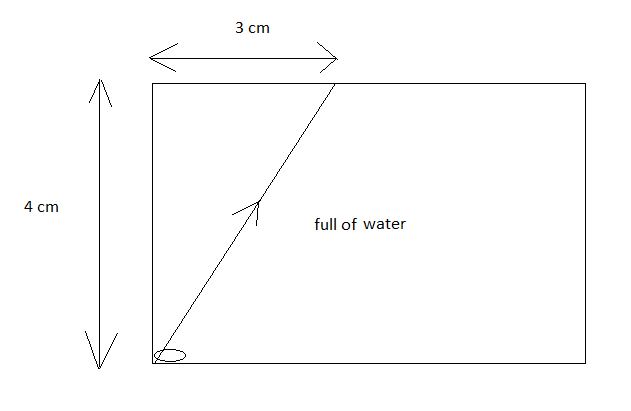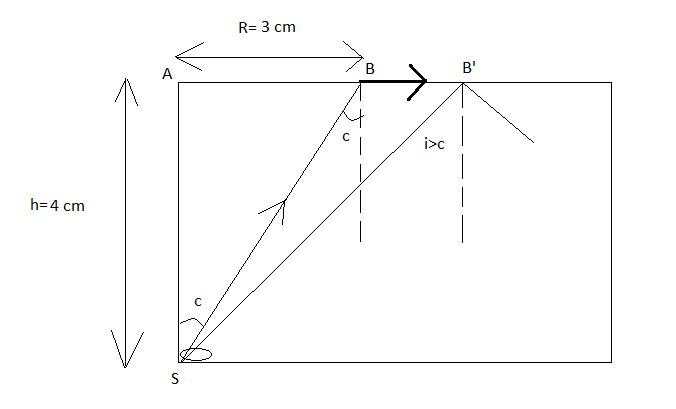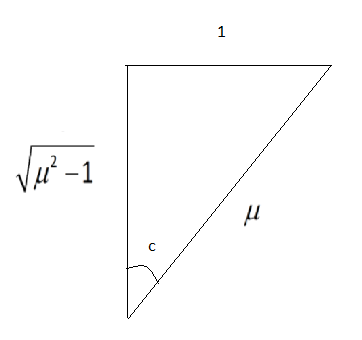
A small coin is resting on the bottom of a beaker filled with a liquid. A ray of light from the coin travels up to the surface of the liquid and moves along its surface (see figure)
How fast is the light travelling in the liquid?

A. \[3 \times {10^8}\,{\text{m/s}}\]
B. \[1.8 \times {10^8}\,{\text{m/s}}\]
C. \[2.4 \times {10^8}\,{\text{m/s}}\]
D. \[3.0 \times {10^8}\,{\text{m/s}}\]

Answer
566.7k+ views
Hint: First of all, we will draw the diagrams, for which it will become much easier. Then we will find out the refractive index of the liquid medium. After that using the refractive index and the velocity of light in air, we will find out the velocity of light in that medium.
Complete step by step answer:
In the given solution, we are supplied the following data:
A coin is placed at the bottom of a beaker.
The height of the liquid column is \[4\,{\text{cm}}\] .
We are asked to find the velocity of light in the liquid.
The critical angle is that angle of incidence in the denser medium for which the refracted ray emerges out at right angle in the lighter or rarer medium. For better understanding we draw a diagram.

First, we will try to find out the refractive index of the liquid. Without finding the refractive index, we won’t be able to find the velocity of light in the liquid. From the diagram it is clear that angle \[C\] is the critical angle in the triangle \[SAB\]. The refracted ray will continue to emerge if the angle of incidence is equal to or less than the critical angle. However, if the angle of incidence is more than the critical angle, then the refracted ray will not emerge out of the liquid, rather it will be reflected back inside the liquid.
The minimum radial distance for which the angle of incidence is equal to the critical angle is \[R\] .
Now we apply a trigonometric ratio tangent in the triangle \[SAB\] .
\[\tan C = \dfrac{R}{h}\] …… (1)
Where,
\[R\] indicates the radial distance.
\[h\] indicates the height of the liquid column.
From equation (1), we can write:
\[R = h\tan C\] …… (2)

From the figure, we can write:
\[\tan C = \dfrac{1}{{\sqrt {{\mu ^2} - 1} }}\]
From equation (1), we get, by substituting the required values:
\[
\dfrac{1}{{\sqrt {{\mu ^2} - 1} }} = \dfrac{R}{h} \\
\Rightarrow \dfrac{1}{{\sqrt {{\mu ^2} - 1} }} = \dfrac{3}{4} \\
\Rightarrow \sqrt {{\mu ^2} - 1} =\dfrac{4}{3} \\
\Rightarrow {\mu ^2} - 1 = {\left( {\dfrac{4}{3}} \right)^2} \\
\]
Again, we simplify further, and we get:
\[
{\mu ^2} = \dfrac{{16}}{9} + 1 \\
\Rightarrow {\mu ^2} = \dfrac{{25}}{9} \\
\Rightarrow \mu =\dfrac{5}{3} \\
\Rightarrow \mu = 1.67 \\
\]
Therefore, the refractive index of the liquid is found to be \[1.67\] .
Now, we find the velocity of light by using refractive index by the formula:
\[\mu = \dfrac{c}{v}\] …… (3)
Where,
\[\mu \] indicates the refractive index of the liquid.
\[c\] indicates the velocity of light.
\[v\] indicates the velocity of light in the liquid medium.
Now, substituting the required values in the equation (3), we get:
\[
v = \dfrac{c}{\mu } \\
\Rightarrow v = \dfrac{{3 \times {{10}^8}\,{\text{m/s}}}}{{1.67}} \\
\Rightarrow v = 1.79 \times {10^8}\,{\text{m/s}} \\
\Rightarrow v \sim 1.8 \times {10^8}\,{\text{m/s}} \\
\]
Hence, the velocity of light in the liquid medium is \[1.8 \times {10^8}\,{\text{m/s}}\] .
The correct option is B.
Note:This problem can be solved if we have some knowledge of refraction of light. It is important to note that the refracted ray will not emerge out of the liquid if the angle of incidence is more than that of the critical angle. Critical angle is a specific property of a medium. Always remember that higher the magnitude of refractive index is, slower is the light travels in that particular medium or vice-versa.
Complete step by step answer:
In the given solution, we are supplied the following data:
A coin is placed at the bottom of a beaker.
The height of the liquid column is \[4\,{\text{cm}}\] .
We are asked to find the velocity of light in the liquid.
The critical angle is that angle of incidence in the denser medium for which the refracted ray emerges out at right angle in the lighter or rarer medium. For better understanding we draw a diagram.

First, we will try to find out the refractive index of the liquid. Without finding the refractive index, we won’t be able to find the velocity of light in the liquid. From the diagram it is clear that angle \[C\] is the critical angle in the triangle \[SAB\]. The refracted ray will continue to emerge if the angle of incidence is equal to or less than the critical angle. However, if the angle of incidence is more than the critical angle, then the refracted ray will not emerge out of the liquid, rather it will be reflected back inside the liquid.
The minimum radial distance for which the angle of incidence is equal to the critical angle is \[R\] .
Now we apply a trigonometric ratio tangent in the triangle \[SAB\] .
\[\tan C = \dfrac{R}{h}\] …… (1)
Where,
\[R\] indicates the radial distance.
\[h\] indicates the height of the liquid column.
From equation (1), we can write:
\[R = h\tan C\] …… (2)

From the figure, we can write:
\[\tan C = \dfrac{1}{{\sqrt {{\mu ^2} - 1} }}\]
From equation (1), we get, by substituting the required values:
\[
\dfrac{1}{{\sqrt {{\mu ^2} - 1} }} = \dfrac{R}{h} \\
\Rightarrow \dfrac{1}{{\sqrt {{\mu ^2} - 1} }} = \dfrac{3}{4} \\
\Rightarrow \sqrt {{\mu ^2} - 1} =\dfrac{4}{3} \\
\Rightarrow {\mu ^2} - 1 = {\left( {\dfrac{4}{3}} \right)^2} \\
\]
Again, we simplify further, and we get:
\[
{\mu ^2} = \dfrac{{16}}{9} + 1 \\
\Rightarrow {\mu ^2} = \dfrac{{25}}{9} \\
\Rightarrow \mu =\dfrac{5}{3} \\
\Rightarrow \mu = 1.67 \\
\]
Therefore, the refractive index of the liquid is found to be \[1.67\] .
Now, we find the velocity of light by using refractive index by the formula:
\[\mu = \dfrac{c}{v}\] …… (3)
Where,
\[\mu \] indicates the refractive index of the liquid.
\[c\] indicates the velocity of light.
\[v\] indicates the velocity of light in the liquid medium.
Now, substituting the required values in the equation (3), we get:
\[
v = \dfrac{c}{\mu } \\
\Rightarrow v = \dfrac{{3 \times {{10}^8}\,{\text{m/s}}}}{{1.67}} \\
\Rightarrow v = 1.79 \times {10^8}\,{\text{m/s}} \\
\Rightarrow v \sim 1.8 \times {10^8}\,{\text{m/s}} \\
\]
Hence, the velocity of light in the liquid medium is \[1.8 \times {10^8}\,{\text{m/s}}\] .
The correct option is B.
Note:This problem can be solved if we have some knowledge of refraction of light. It is important to note that the refracted ray will not emerge out of the liquid if the angle of incidence is more than that of the critical angle. Critical angle is a specific property of a medium. Always remember that higher the magnitude of refractive index is, slower is the light travels in that particular medium or vice-versa.
Recently Updated Pages
A man running at a speed 5 ms is viewed in the side class 12 physics CBSE

The number of solutions in x in 02pi for which sqrt class 12 maths CBSE

State and explain Hardy Weinbergs Principle class 12 biology CBSE

Write any two methods of preparation of phenol Give class 12 chemistry CBSE

Which of the following statements is wrong a Amnion class 12 biology CBSE

Differentiate between action potential and resting class 12 biology CBSE

Trending doubts
What are the major means of transport Explain each class 12 social science CBSE

Which are the Top 10 Largest Countries of the World?

Draw a labelled sketch of the human eye class 12 physics CBSE

How much time does it take to bleed after eating p class 12 biology CBSE

Explain sex determination in humans with line diag class 12 biology CBSE

When was the first election held in India a 194748 class 12 sst CBSE




